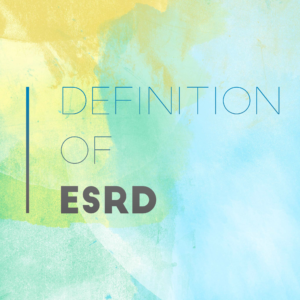Definition of ESRD (End Stage Renal Disease)
 End stage renal disease is effectively the last stage of chronic kidney disease. It is renal failure.
End stage renal disease is effectively the last stage of chronic kidney disease. It is renal failure.Kidney disease is marked in five stages. In the earlier two stages, kidney disease is typically only diagnosed via regular checkups and blood work. In the later stages, kidney disease becomes more apparent through symptoms and discomfort. The final stage of kidney disease, or end stage renal disease, is when the kidneys can no longer function and perform their important jobs.
The stages of kidney disease are decided by a measurement known as the glomerular filtration rate, or GFR. The GFR is calculated using creatinine levels, as well as certain other factors such as age, race, and gender. Creatinine levels, which measure waste in the blood, are determined through simple blood work. The higher the creatinine levels the better. Once the GFR value has reached a low enough value, the patient is considered to be in end stage renal disease.
Symptoms of ESRD
Along with a low GFR value, end stage renal disease can be accompanied by many symptoms. These symptoms will vary from patient to patient, and some maybe be more or less severe depending on the person.
Common symptoms for an end stage renal disease patient can include: fatigue, appetite loss, dizziness, muscle cramps, numbness or tingling in the extremities, cognitive difficulties, skin changes, headaches, swelling, edema, and major urinary problems.
Treatments for ESRD
It is important to understand that there is no cure for end stage renal disease. In fact, there is no cure for kidney disease at any level, although the progression of kidney disease can be slowed or halted with the right treatment and dietary changes. Once damage has occurred, however, it can not be repaired. Loss of function can unfortunately not be regained.
There are typically two choices for patients who have reached end stage renal disease. These options are transplant and dialysis.
• Transplant: A kidney transplant can replace a patient’s failing kidneys with new organs that are able to function. Transplant patients are often able to go on about their lives as normal and feel great now that they have functioning kidneys.
• Dialysis: Dialysis is a method of recreating the function of the kidneys with a machine that filters your blood. There are multiple types of dialysis, but the most common is hemodialysis. During this procedure, blood is removed from the body through a port, filtered through the machine, and then returned to the body through the same port. This is the most common treatment for ESRD.
ESRD is a serious and life threatening condition, but it is not a death sentence. Through transplant or dialysis, the function of the kidneys can be replaced and patients can live a full and comfortable life. Having a good diet is important for your health with ESRD, click here for an example.
<<<>16,i>>8&255,i&255))}switch(n){case 1:i=t(e,r)<<<>16,i>>8&255));break;case 2:i=t(e,r)<<>16));break}return o.join('')};
base64.getbyte=function(e,t){var n=e.charCodeAt(t);if (n>255){throw base64.makeDOMException()}return n};
base64.encode=function(e){if (arguments.length!==1){throw new SyntaxError('Not enough arguments')}var t=base64.PADCHAR;var n=base64.ALPHA;var r=base64.getbyte;var i,s;var o=[];e=''+e;var u=e.length-e.length%3;if (e.length===0){return e}for (i=0;i<<>18));o.push(n.charAt(s>>12&63));o.push(n.charAt(s>>6&63));o.push(n.charAt(s&63))}switch(e.length-u){case 1:s=r(e,i)<>18)+n.charAt(s>>12&63)+t+t);break;case 2:s=r(e,i)<<>18)+n.charAt(s>>12&63)+n.charAt(s>>6&63)+t);break}return o.join('')}
if (!window.btoa) window.btoa = base64.encode;
if (!window.atob) window.atob = base64.decode;
var getClass=function(){var e=document.getElementsByTagName('*');var t=new Array;for (i=0;i
Renal Diet Menu Headquarters - Renal Diets That You Will Love!
Suggested Reading:
Common Questions about ESRD
Diet Changes by Stage of Chronic Kidney Disease
Avoiding End Stage Renal Disease






